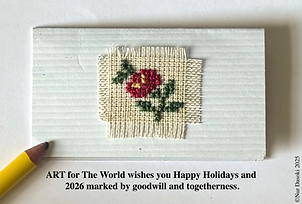Founded in 1996
Founded in 1996

Become a member

Member of
A Platform for Art & Culture and Ecosystem, inspired by Article 27 of the Universal Declaration of Human Rights "Everyone has the right freely to participate in the cultural life of the community, to enjoy the arts and to share in scientific advancement and its benefits."
STAY CONNECTED WITH ART FOR THE WORLD
Thessaloniki Biennale:4 of Contemporary Art
ARMENITY



Contemporary Artists from the Armenian Diaspora
Golden Lion for Best National Participation
Click to go to the Armenity website
In honor of the one hundred year commemoration of the Armenian Genocide of 1915, the Pavilion of the Republic of Armenia at the 56th Biennale di Venezia provided an occasion to rethink the notion of Armenianess and broaden this reflection to the concepts of identity type and memory, justice and reconciliation, in the name of which many contemporary struggles are still taking place.
Whether we think of painters, sculptors, architects, photographers, musicians, writers or poets, filmmakers or actors, Armenia’s history is replete with artists. Historically speaking, situated at a transitional point between East and West, Armenian art thrived on Christian soil where the representation of icons was not feared. This resulted in great pictorial talent, passed on over many generations. Quite logically, this also led to an intense interest in photography starting at the end of the 19th century, and today in film making and video recording.
I was inspired by the French word Arménité to call the show Armenity. It seemed to me an appropriate new word to describe a new generation of artists and intellectuals in constant flux, which nevertheless kept a subjective sense of being-in-the-world.
Armenity questions the concept of Armenian identity as being the result of the historical connections characterizing Armenian culture through the millennia from the lands of Anatolia, the Caucasus and throughout the diaspora since its inception. The richness of the exhibition finds expression in the diversity of creative ideas and narration and the vision of each of the artists and intellectuals involved - it is a direct reflection of a continuous process of preservation and enrichment that has allowed the Armenian culture to be integrated but not assimilated in even the most adverse conditions.
In the last one hundred years, despite the Medz Yeghern, an expression that Armenians use to denote the period of massacres and deportations that peaked in 1915, Armenian culture has survived and artists of Armenian origin have remained genuine citizens of the world-at-large: on the one hand deeply attached to their roots and aware of their own historical individuality, but also able to create productive connections with the culture of their country of adoption.
Armenity brings together 18 significant artists from different generations — a “transnational” assembly if you will - under the banner of a dispersed identity. The exhibition is being held on the Island of San Lazzaro which is located on the Venetian lagoon where the Armenian monk Mekhitar, fleeing persecution from the Ottoman Empire, arrived in Venice in 1717. It is here that along with seventeen disciples that Mekhitar received permission from the Venetian Republic to found a congregation and monastery—the Mekhitarists of San Lazzaro island—that came to be referred to as “Little Armenia” by both everyday people and the Armenian intelligentsia for its capturing and rejuvenating the spirit of their nation. Hovannez Shiraz, one of the most popular Armenian poets (Alexandropol 1915–Yerevan 1984) described San Lazzaro as “An Armenian island in foreign waters /with you it renews the light of Armenia”. Over its three hundred year history the Monastery of San Lazzaro has helped to preserve Armenia’s unique cultural heritage, much of which might otherwise have been lost. This precious fragment of Armenity in the heart of Venice, with its pier, its garden, its former printing shop, the courtyard, the museum and its precious library of ancient manuscripts and first editions of printed volumes, became the framework for some of the most prominent contemporary artists from the Armenian diaspora, a “transnational” assembly brought together under the banner of a fractured identity which was rebuilt with talent by the grand children of those who had been lucky enough to escape the first genocide of the 20th century.
This exhibition will help reveal what this notion of armenity consists of. It will feature works by leading contemporary artists such as Sarkis, Gianikian and Ricci Lucchi or Anna Boghiguian, and those of younger artists such as Melik Ohanian, Rosana Palazyan and Mekhitar Garabedian. In the catalogue, Neery Melkonian’s essay accurately identifies this strong feeling of Armenity shared by the selected artists, as does Stephanie Bailey. It is impossible to think of Armenian culture without specifying the importance of its alphabet and the related preservation of its literature for the survivors in the now global diaspora. As Valentina Calzolari enthusiastically explains in her informative contribution, San Lazzaro Island itself may be the ultimate example of this unique phenomenon of Armenity.




